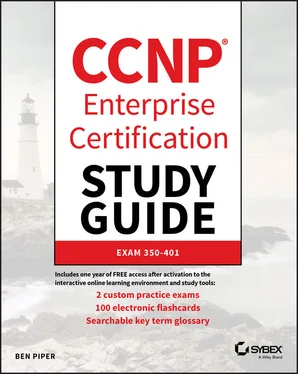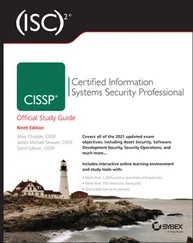7 Chapter 3: Enterprise Network Design Physical Network Architectures Layer 2 Design EtherChannels First-Hop Redundancy Protocols Summary Exam Essentials Review Questions
8 Chapter 4: Wireless LAN (WLAN) Radio Frequency Fundamentals WLAN 802.11 Standards Access Point Modes Roaming and Location Services Summary Exam Essentials Review Questions
9 Chapter 5: Open Shortest Path First (OSPF) Link-State Advertisements Neighbor Operations Configuring OSPF Summary Exam Essentials Exercises Review Questions
10 Chapter 6: Enhanced Interior Gateway Routing Protocol (EIGRP) EIGRP Fundamentals Configuring EIGRP Summary Exam Essentials Exercises Review Questions
11 Chapter 7: The Border Gateway Protocol (BGP) BGP Fundamentals Configuring BGP Summary Exam Essentials Exercises Review Questions
12 Chapter 8: Network Address Translation and Multicast Network Address Translation Multicast Summary Exam Essentials Exercises Review Questions
13 Chapter 9: Quality of Service Understanding Quality of Service Classification and Marking Policing Queuing Shaping Summary Exam Essentials Exercises Review Questions
14 Chapter 10: Network Virtualization Virtual Machines, Hypervisors, and Network Virtualization Generic Routing Encapsulation Tunnels IP Security Location/ID Separation Protocol Virtual Extensible Local Area Network Virtual Routing and Forwarding Summary Exam Essentials Exercises Review Questions
15 Chapter 11: Software-Defined Networking and Network Programmability What Is Software-Defined Networking? Software-Defined Access Software-Defined WAN Network Programmability and Automation Summary Exam Essentials Exercises Review Questions
16 Chapter 12: Network Security and Monitoring Infrastructure Security Cisco Security Products Wireless Security Monitoring Summary Exam Essentials Exercises Review Questions
17 Appendix Answers to Review Questions Chapter 1: Networking Fundamentals Chapter 2: Spanning Tree Protocols Chapter 3: Enterprise Network Design Chapter 4: Wireless LAN (WLAN) Chapter 5: Open Shortest Path First (OSPF) Chapter 6: Enhanced Interior Gateway Routing Protocol (EIGRP) Chapter 7: The Border Gateway Protocol (BGP) Chapter 8: Network Address Translation and Multicast Chapter 9: Quality of Service Chapter 10: Network Virtualization Chapter 11: Software-Defined Networking and Network Programmability Chapter 12: Network Security and Monitoring
18 Index
19 Online Test Bank
20 End User License Agreement
1 Chapter 1 Table 1.1 Table 1.2 Table 1.3
2 Chapter 2 Table 2.1
3 Chapter 3 Table 3.1 Table 3.2 Table 3.3 Table 3.4
4 Chapter 4 Table 4.1 Table 4.2 Table 4.3
5 Chapter 8 Table 8.1
6 Chapter 9 Table 9.1 Table 9.2
7 Chapter 11 Table 11.1 Table 11.2
8 Chapter 12 Table 12.1 Table 12.2
1 Chapter 1 Figure 1.1How layers abstract the network from an application Figure 1.2At each layer, data is encapsulated in a PDU and passed down to the n... Figure 1.3Layer 2 frame and layer 1 packet, structurally identical to the revis... Figure 1.4Early Ethernet over a shared medium compared to Ethernet using a swit... Figure 1.5Simple layer 2 and layer 3 topologies Figure 1.6Layered representation of the network Figure 1.7Encapsulation of a TCP segment and IP packet inside an Ethernet frame...
2 Chapter 2 Figure 2.1Physical looped topology Figure 2.2Converged STP topology with SW1 as the root Figure 2.3Multiple VLANs over 802.1Q trunks Figure 2.4Converged STP topology with SW3 as the new root Figure 2.5VLAN 1 topology with SW3 as root Figure 2.6Converged VLAN 1 topology with SW2 Gi1/0... Figure 2.7Multiple Spanning Tree Figure 2.8Physical topology for Exercise 2.1
3 Chapter 3 Figure 3.1East-West traffic flow in a data center network using the leaf... Figure 3.2Core, distribution, and access tiers Figure 3.3Two access-distribution blocks connected to the core Figure 3.4Collapsed core Figure 3.5Switched vs. routed topology Figure 3.6A looped triangle topology Figure 3.7A looped square topology Figure 3.8Recommended loop-free topology Figure 3.9Loop-free U-topology Figure 3.10Loop-free inverted-U topology Figure 3.11Virtual switch topology Figure 3.12Routed access topology Figure 3.13EtherChannel between SW3 and SW4
4 Chapter 4 Figure 4.1Representation of radio wave at 10 Hz with an amplitude of 1... Figure 4.2Amplitude decreases with the square of the distance.
5 Chapter 5 Figure 5.1An OSPF topology Figure 5.2Layer 2 topology
6 Chapter 6 Figure 6.1Simple EIGRP topology Figure 6.2EIGRP weighted metric formula Figure 6.3EIGRP layer 3 topology Figure 6.4Layer 2 topology
7 Chapter 7 Figure 7.1BGP peers in different autonomous systems Figure 7.2Route propagation and loop prevention among BGP neighbors in... Figure 7.3Layer 3 topology using BGP, OSPF, and EIGRP
8 Chapter 8 Figure 8.1Inside versus outside networks Figure 8.2Static NAT Figure 8.3Layer 3 topology Figure 8.4Layer 2 topology Figure 8.5Multicast topology
9 Chapter 9 Figure 9.1Setting a QoS profile Figure 9.2The Platinum QoS profile
10 Chapter 10 Figure 10.1L2 VM-to-VM traffic using a virtual switching... Figure 10.2L2 VM-to-switch traffic using a virtual switc... Figure 10.3L3 VM-to-VM traffic using a virtual switch an... Figure 10.4L2 VM-to-VM traffic switched internally using... Figure 10.5L2 VM-to-VM traffic switched externally using... Figure 10.6Underlay topology running BGP. R1 (AS 65001) and R2 (AS 650... Figure 10.7GRE topology Figure 10.8Using LISP for IP mobility Figure 10.9VXLAN flood-and-learn configuration using mul... Figure 10.10VRF topology
11 Chapter 11 Figure 11.1Scalable groups in Cisco DNA Center Figure 11.2Group-based access control policies in Cisco DNA Center Figure 11.3Network Settings page under the Design workflow of Cisco DNA Center Figure 11.4Inventory page under the Provision workflow of Cisco DNA Center Figure 11.5Fabric Infrastructure page under the Provision workflow of Cisco DNA... Figure 11.6Fabric Host Onboarding page under the Provision workflow of Cisco DN... Figure 11.7The Overall Health dashboard in the Assurance workflow of Cisco DNA ... Figure 11.8The Application Health dashboard in the Assurance workflow of Cisco ... Figure 11.9The Client Health dashboard in the Assurance workflow of Cisco DNA C... Figure 11.10The vManage Network Management System web interface
12 Chapter 12 Figure 12.1Example network topology Figure 12.2WebAuth login page configuration Figure 12.3WLAN list Figure 12.4WLAN layer 2 configuration Figure 12.5RADIUS server configuration Figure 12.6AAA server configuration Figure 12.7WLAN WPA2 and 802.1X configuration Figure 12.8Specifying security and encryption authentication method Figure 12.9Specifying user authentication mode Figure 12.10Setting a WPA/WPA2 preshared key
Читать дальше












